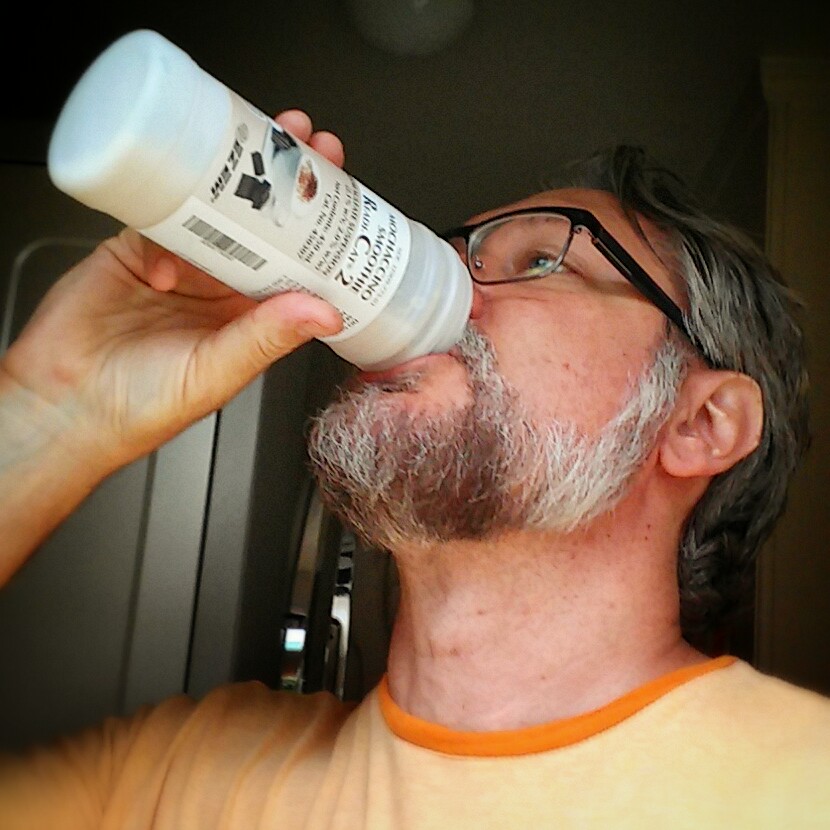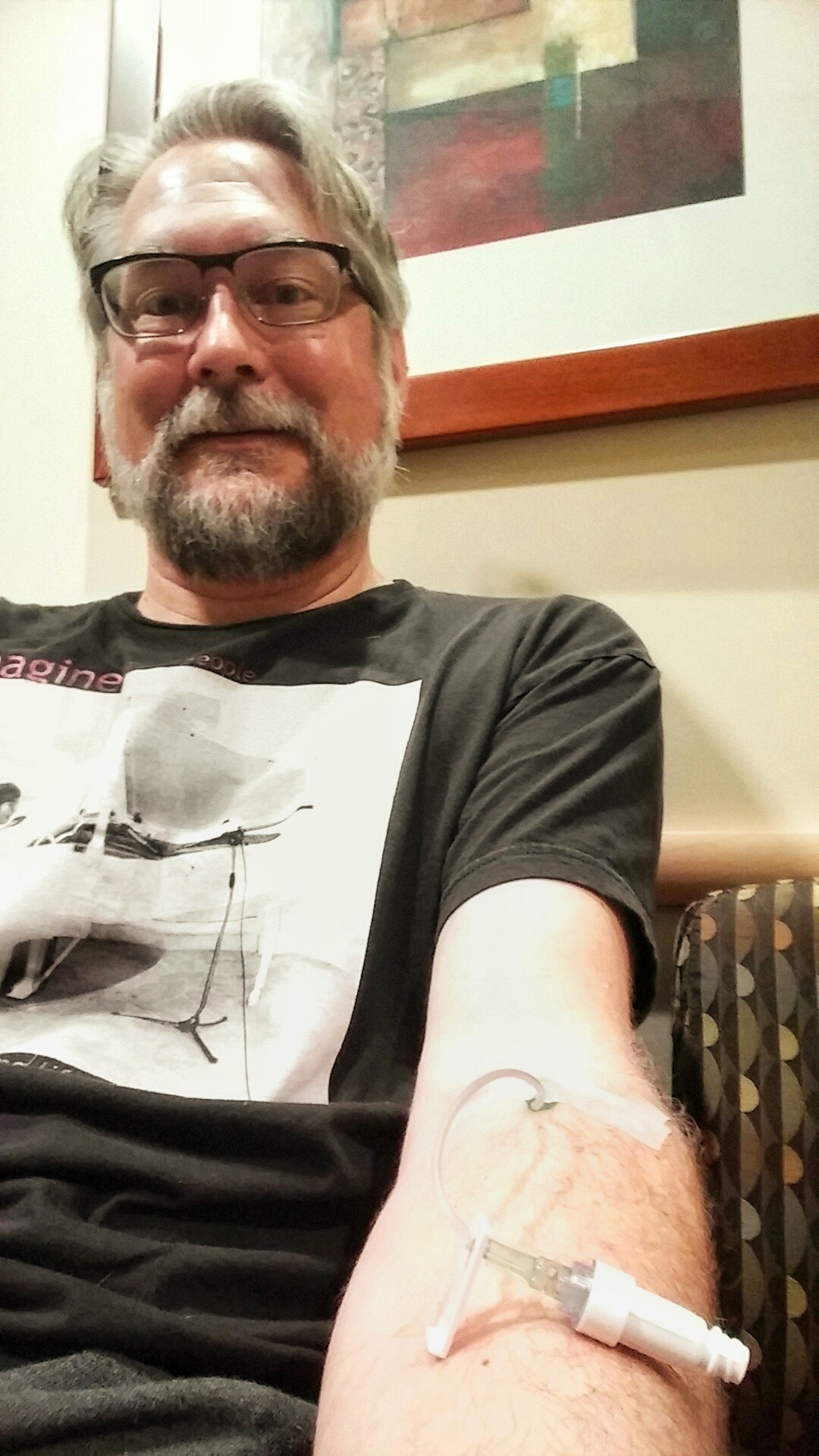
Drinking barium sulfate has become somewhat less disgusting since they introduced the mochaccino flavor, it’s true. One of the ladies in reception noticed my second bottle of the morning during my check-in and mentioned that she heard it was “pretty good.” I told her that “more palatable” was a better description, but it is admitedly a huge leap over the nasty flavors offered just a few months ago. Just one additional way in which science is continuing to earn that motto, “better living through chemistry.”
And the fasting; I hate the fasting. Not that I can really complain about four hours between 6:30 and 10:30 in the morning — since these are my usual hours between breakfast and my late-morning snack, I got off easy today. My scans are usually a bit earlier and I can’t sneak a meal in, but today I got lucky. That’s why, I suppose, I was in an especially good mood upon arrival.
 The folks at the imaging center are always terrific. They remember me far better than I can remember them, it seems. Granted, I’ve been there so many times it seems I have lost count. But it isn’t really that I’ve lost count, more like I’m just too lazy to go back and make note of each one in my head. I’ve had a few visits, let’s say, and each has left me feeling pretty good. Which might sound odd, considering why I am going. But the fact is that since the beginning of my adventure with adenocarcinoma, scans of any sort have made me feel better.
The folks at the imaging center are always terrific. They remember me far better than I can remember them, it seems. Granted, I’ve been there so many times it seems I have lost count. But it isn’t really that I’ve lost count, more like I’m just too lazy to go back and make note of each one in my head. I’ve had a few visits, let’s say, and each has left me feeling pretty good. Which might sound odd, considering why I am going. But the fact is that since the beginning of my adventure with adenocarcinoma, scans of any sort have made me feel better.
Perhaps it is psychosamatic; I enjoy knowing what is going on and a scan equals more information. Maybe it is my Bruce Banner fantasy, that the radiation is somehow making me stronger. (PET scans, of which I have had only one, are modified CT scans with the addition of injecting the subject with gamma radiation. I felt massively energized after that scan when I had it last year.) For whatever reason, when they shoot X-rays at me or have me drink a radioactive mock-coffee, I am invigorated.
So I laid down on this contraption and they shot all sorts of tiny particles through my body to make these nifty images that allow me to journey virtually through a cross section of my torso. Usually I get a copy of the images to take home but the CD burner was out of commission today. Luckily, I got an email from my oncologist only a few hours later to let me know that it looks good.
By that, I mean that the tumor appears to be continuing to gradually shrink and there is no sign of activity increasing anywhere else, so I continue to be in parital remission and feel quite happy about that. Another feather in the cap of Mr. Science. The chemotherapy, with all of its little side effects — most of which change from month to month in one exciting degree or another — is continuing to do its job. Granted, and I always say this, I am certain that I have been helped a lot by beginning this process in relatively good shape, excellent overall health and with an appropriately aggressive attitude about the treatment. But ultimately it is the nature of the chemo and the decades of study that preceded me to which I owe the biggest debt. The doctors and researchers who made all this possible have done something truly amazing for so many people.
Which is one of the reasons that I get so very, very angry when I read about things like “Baking Soda Cures” on the Internet.
I have spent a lot of time looking over the web site of one “Doctor” Leonard Coldwell recently, because he claims to have cured — and he uses the word repeatedly and boastfully — more cancer patients than any other doctor. In fact, he claims to have cured over 35,000 cancer patients. Wow, that’s a lot of cancer patients to cure. Since the same page mentions that his first patient, his mother, was cured 43 years ago, that means he would have to have cured over 800 patients per year on average. That means almost 16 per week! Taking weekends off but no holidays, could any oncologist lay claim to curing three cancer patients each and every work day for 43 years? It’s an absurd claim. But it fits right in with the other egregious nonsense on his site (linked throughout to other sites he is associated with hawking supplements, seminars and the like).
This guy has a whole mini industry set up around his personal brand, selling books and CDs for his hysterically named “Instinct Based Medicine” and nutritional aids that cannot possibly live up to their hype. He also has established himself as a darling of conspiracy-theory media outlets, the anti-vaccination movement and those purveyors of misinformation he likes to call “fellow freedom fighters.” His web presence is huge. He tries hard to appear legitimate, claiming endorsements by or affiliations with such luminaries as “Miss Australia” and “Chamber of Commerce” as well as Comcast and NASA. One of the wonderful things about his ringing endorsements and plethora of awards is that by and large, there is no indication where they come from or what they really mean. (“Most Loved Speaker of All Times” is my favorite of his awards, but I have absolutely no idea in which context that would be given.) Also, and I quote from his Junk Endorsements for Junk Science, “Dr. Coldwell received recognition and thankyou letters from the White House, US President George W. Bush and the US Congress.”
It’s easy to laugh at all of that, until you get into the comments section of the Baking Soda page. The description of the “cure” promoted on that page is pretty awful in and of itself. The author takes no shame in frightening the reader about how dreadful chemotherapy, radiation and surgery are and then placating with the information that there is a gentle alternative that completely works by using only natural ingredients. It’s a typical lie, one that is so transparently impossible to anyone who stayed awake in high school biology class, and yet there are (as of this writing) 176 comments following the nonsensical claim about this baking soda cure and virtually every one of those is either a desperate plea for help or a resounding endorsement for the idiocy in the article.
As I read through the comments, I actually wept. This was weeks ago, but it stayed with me. I decided to post a few comments, suggesting that people consider the biological reasons that the touted “cure” could not actually do anything at all, and found that there was no one listening to my information. The best I got was a surprising “you’re entitled to your opinion” response from the page administrator. The fact that my comment was posted was shocking, but the unwillingness to engage in an actual discussion about why the “cure” was either ineffective or dangerous was no surprise at all. My follow up comment was allowed through, but shut down — and my last comment was never posted. This is the thing about these sites: they do not like being challenged and they are unwilling to offer anything even remotely scientific to support their claims, even when they continue to state that science backs them up. And here were easily 100 people, writing with their problems and fears and in some cases obvious hatred toward the mainstream medical community, who were being led down a rabbit hole rather than offered anything in the way of actual help or even viable information.
Cancer predators are out there by the hundreds, if not thousands. When we, as patients, look around for assistance in guiding our decisions, it is easy to be taken in by these monsters. Many of them, surely, are merely gullible or have fallen prey to their own fears. But the masterminds behind so many of these scams make me sick.
I am a very fortunate person and I know it. I understand how much progress has been made in the area of cancer treatment and I live in an area where I can benefit from these advances. None of that is lost on me. This all makes me doubly sad for those for whom outdated concepts of cancer treatment hold strong: the fears of chemotherapy as a poison that kills rapidly or radiation that burns or surgery that mutilates as though by the hand of a butcher. Such paranoia is fostered by purveyors of “alternative treatments” in order to get more business, but at the potential expense of lives that could be spared or perhaps greatly extended. There are plenty of stories about people choosing such alternative routes when their particular cancer was in an actually curable stage only to die because they did not turn to traditional medicine until it was too late. There are no verifiable stories, however, of these alternatives delivering on their promises.
One thought on “Scanning the Options”